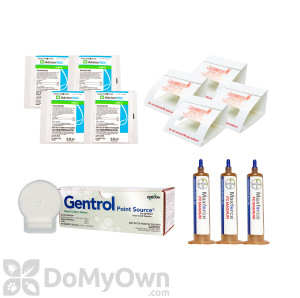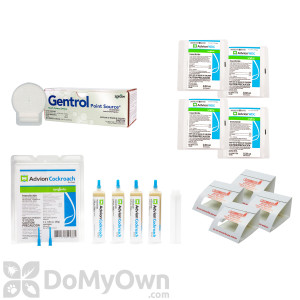- 1/2 inch- 5/8 inch long
- light to medium brown with 2 dark distinctive stripes behind the head
- babies (nymphs) are wingless, smaller and much darker in color, with a light stripe on their backs
General
The German cockroach is the most common roach found in apartments, houses, hotels, and restaurants. German cockroaches and their eggs are usually transported into buildings on a person's belongings, luggage, or boxes. It only takes one small egg capsule and you have an infestation six months later. This species is also one of the most challenging to get rid of.
Habitat
German roaches require moisture to thrive and so tend to dwell in moist places, such as kitchens and bathrooms. However, they may inhabit any room of a structure or home, particularly if the infestation is severe. German cockroaches spend about 75% of their time hanging out in cracks and crevices near food and water sources. Adult German cockroaches can hide inside cracks as small as 3/16" wide, while the nymphs can fit into cracks as small as 1/32" wide.
Feeding Habits
The German cockroach will eat practically anything and will live very close to food and water sources. They eat sweets, starches, grease, and meat products; but will also feed on beer, leather, book bindings, hair, glue, dried skin, dead animals and plant material.
Reproduction & Life Cycle
The female German cockroach produces an egg capsule every 3 to 4 weeks, with each capsule containing 25-45 eggs. Rather than depositing the sack, the female carries the capsule with her and protects it until it hatches. This is another reason the German cockroach is so difficult to get rid of-its nymphs are well protected. These young nymphs will begin breeding again in as little as 36 days. Adult German cockroaches can live up to 365 days.
Damage
German cockroaches can multiply very quickly and become a nuisance in large numbers. Cockroaches are unsightly, intrude on our homes and lives, contaminate food, and are capable of transmitting diseases.
Basic Control Methods
- For indoor infestations, spray Suspend SC all along the baseboards, window and door frames, and underneath appliances using a handheld sprayer. Repeat this treatment every two to three months.
- Dust underneath baseboards and inside wall voids with Delta Dust.
- Outdoors, use a residual spray such as Talstar One or Cynoff WP around all points of possible entry including windows and door frames, dryer vents, and pipe openings. Use the same residual spray indoors along baseboards and framed entry points.
- Recommended baits for German cockroach control include Maxforce Roach Gel, Maxforce Roach BaitStations, Advion Cockroach Bait Gel, and Avert Dry Flowable Bait.
For more detailed information on German cockroach prevention and control, see How to Get Rid of German Cockroaches
View all Roach Control Products





